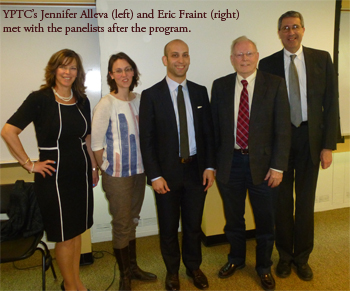
Or three of them, actually. YPTC’s annual all-staff training session invited three renowned authorities in nonprofit law to speak to us about what drew them into this field and to answer questions about the pitfalls and success stories they’ve seen in their years of practice.
WHAT DREW YOU INTO NONPROFIT LAW?
“I’m not sure that I had an ‘Aha! Moment,’ but looking back I can see the pieces that fit together,” said Morgen Cheshire, a Philadelphia attorney and founder of the Cheshire Law Group who has dedicated her career to nonprofit law. Starting with a background in arts and cultural organizations, she entered law school hoping to go into art law – only to find such courses didn’t exist at her school.
After finally finding an art law concentration at Columbia University, she was working in trusts and estates when another attorney needed help with some tax-exempt issues affecting family foundations and other nonprofits.
“I got to know our clients as a whole, not just the tax compliance piece of it, and I became the go-to person in our firm for nonprofit work. Whether it was trademark or employee issues, I got to make sure all their issues were being addressed comprehensively,” she said.
“What’s really wonderful for me is being the general counsel for nonprofits and seeing organizations holistically. You have to be able to think creatively and collaboratively to get nonprofits what they need. And today I can come back to being an art lawyer: many of my clients are art organizations or have substantial art collections and I can work on licensing and lending agreements.”

Don Kramer, whose expertise spans 40 years to a time when there were no such things as nonprofit law, philanthropy roundtables or the Chronicle of Philanthropy, described how his early interest in public policy eventually took root at Montgomery McCracken Walker & Rhoads LLP.
Editor and publisher of Don Kramer’s Nonprofit Issues and a lecturer at several universities, Kramer said he stays with the field “because I find it very interesting — mainly because my clients are such interesting people. They’re always doing something to make the world a better place.”
WHAT LEGAL ISSUES DOES THE NONPROFIT SECTOR FACE?

The three were eager to share with YPTC staff their favorite “war stories” that exemplified some of the many legal issues facing the nonprofit sector.
Takis described a public TV station that was planning to spin off a for-profit entity at the same time the IRS had revoked its tax-exempt status due to faults with its 990 forms.
Cheshire recalled a nonprofit that had fired its executive director for suspected embezzlement: when the district attorney’s office declined to prosecute, she advocated for the organization by organizing forensic accounting and a media campaign. Restitution was made and the nonprofit’s national association used the incident as a teachable moment to help similar local organizations strengthen their governance practices.
Kramer related having to “write the rules as we went along” back in the 1980s to deal with receivership, governance and hospital conversion issues that had never been addressed before.
Some of the more common legal problems the attorneys see include:
-
- nonprofit boards breaching their fiduciary responsibility by failing to follow their own bylaws;
- compliance issues from failing to pay payroll taxes;
- misclassifying workers as independent contractors rather than paid staff;
- mistakenly categorizing workers as salaried employees so as to not have to fill out timesheets and pay overtime; and
- failing to register as a charitable organization in states where they appeal for donations.
Other issues include nonprofits being unclear about the unrelated business tax, particularly among start-up organizations trying to decide whether to incorporate as a nonprofit, for-profit or a hybrid organization. The facts and circumstances test used for such determinations varies by industry and it is best to seek legal counsel for assistance.
YOUR 990: KEY TO ACCOUNTABILITY AND TRANSPARENCY
All agreed that the organization’s IRS Form 990 is a critical document and one that is often overlooked for its significance. “We’ve taken the position for many years that the 990 is your most important PR document,” said Kramer. “Annual reports get sent to the circular file but anyone can see your 990 on Guidestar.”
Some of the common issues the three find on 990s include:
-
- not tracking lobbying expenses correctly, both in terms of allocating employee work time and non-deductible portions of donors’ contributions;
- articulating the mission statement differently than in the articles of incorporation and in publications;
- improper tracking of fundraising revenues and expenses; and
- inaccurate listings of program service accomplishments.
“There’s a whole industry of people who read 990s, especially in the press,” said Kramer, noting that accountability and transparency discrepancies can be a minefield leading to nasty public reaction. Improper reporting of employee compensation and conflict-of-interest transactions can generate newspaper headlines. Saying your board members spend zero hours participating in the organization’s operations implies they are shirking their fiduciary responsibility. If your balance sheets report lots of cash on hand but no savings, prospective donors will wonder why they are being asked to contribute. Ignoring the important work of volunteers can be seen by them as a snub.
They agreed that the 990 is too significant a form to leave to just the auditors. “When I see something wrong with the 990 it’s an indicator to me that something isn’t what it should be systematically,” said Cheshire. “Many organizations don’t spend the time to bring in accountants or legal counsel to work with the auditors to review the document: they think that they’ve already paid a lot of money to one professional and don’t need to bring in another. But the financial side needs to talk to the legal side.” And ideally, added Kramer, that should be someone who understands nonprofit law – not just an attorney serving on the board of directors.
STRENGTHENING BOARD GOVERNANCE

All agreed that diverse representation is a key to successful board governance. Takis related the challenges he encountered in an education organization whose board was comprised exclusively of teachers. “A good nonprofit starts with a strong, diverse board of directors who can help you in areas where you are not an expert. They can set up systems and help with fundraising,” he said.
“The key to a strong board – besides diversity – is to have its people do their homework, show up and ask dumb questions,” said Kramer. “Having a sense that people will participate and diverse opinions will be raised is critical. It’s important to develop the concept that board members can and should question something, especially if they don’t understand it.”







